Convolutional Neural Network Can Recognize Drug Resistance of Single Cancer Cells
Abstract
1. Introduction
2. Results
2.1. Models Constructed to Discriminate Resistance and Non-Resistance of Cancer Cells to Anticancer Drugs in the Confluent Category
2.2. Discrimination Model of the Single-Cell Level
3. Discussion
4. Materials and Methods
4.1. Cell Lines and Cell Culture
4.2. Cytotoxicity Assay
4.3. Preparation of Image for Deep Learning
4.4. The Machine Learning Process with a Neural Network System
Author Contributions
Funding
Acknowledgments
Conflicts of Interest
References
- Watanabe, T.; Muro, K.; Ajioka, Y.; Hashiguchi, Y.; Ito, Y.; Saito, Y.; Hamaguchi, T.; Ishida, H.; Ishiguro, M.; Ishihara, S.; et al. Japanese Society for Cancer of the Colon and Rectum (JSCCR) guidelines 2016 for the treatment of colorectal cancer. Int. J. Clin. Oncol. 2018, 23, 1–34. [Google Scholar] [CrossRef] [PubMed]
- Colvin, H.; Mizushima, T.; Eguchi, H.; Takiguchi, S.; Doki, Y.; Mori, M. Gastroenterological surgery in Japan: The past, the present and the future. Ann. Gastroenterol. Surg. 2017, 1, 5–10. [Google Scholar] [CrossRef] [PubMed]
- Hench, I.B.; Hench, J.; Tolnay, M. Liquid Biopsy in Clinical Management of Breast, Lung, and Colorectal Cancer. Front. Med. 2018, 5, 9. [Google Scholar] [CrossRef] [PubMed]
- Khoo, B.L.; Grenci, G.; Lim, Y.B.; Lee, S.C.; Han, J.; Lim, C.T. Expansion of patient-derived circulating tumor cells from liquid biopsies using a CTC microfluidic culture device. Nat. Protoc. 2018, 13, 34–58. [Google Scholar] [CrossRef] [PubMed]
- Sharma, S.; Zhuang, R.; Long, M.; Pavlovic, M.; Kang, Y.; Ilyas, A.; Asghar, W. Circulating tumor cell isolation, culture, and downstream molecular analysis. Biotechnol. Adv. 2018, 36, 1063–1078. [Google Scholar] [CrossRef] [PubMed]
- Batth, I.S.; Mitra, A.; Rood, S.; Kopetz, S.; Menter, D.; Li, S. CTC analysis: An update on technological progress. Transl. Res. 2019, 212, 14–25. [Google Scholar] [CrossRef]
- Koseki, J.; Konno, M.; Ishii, H. Computational analyses for cancer biology based on exhaustive experimental backgrounds. Cancer Drug Resist. 2019, 2, 419–427. [Google Scholar] [CrossRef]
- Metzcar, J.; Wang, Y.; Heiland, R.; Macklin, P. A Review of Cell-Based Computational Modeling in Cancer Biology. JCO Clin. Cancer Inform. 2019, 3, 1–13. [Google Scholar] [CrossRef]
- Libbrecht, M.W.; Noble, W.S. Machine learning applications in genetics and genomics. Nat. Rev. Genet. 2015, 16, 321–332. [Google Scholar] [CrossRef] [PubMed]
- Zou, J.; Huss, M.; Abid, A.; Mohammadi, P.; Torkamani, A.; Telenti, A. A primer on deep learning in genomics. Nat. Genet. 2019, 51, 12–18. [Google Scholar] [CrossRef] [PubMed]
- Litjens, G.; Kooi, T.; Bejnordi, B.E.; Setio, A.A.A.; Ciompi, F.; Ghafoorian, M.; van der Laak, J.A.W.M.; van Ginneken, B.; Sánchez, C.I. A survey on deep learning in medical image analysis. Med. Image Anal. 2017, 42, 60–88. [Google Scholar] [CrossRef] [PubMed]
- Esteva, A.; Kuprel, B.; Novoa, R.A.; Ko, J.; Swetter, S.M.; Blau, H.M.; Thrun, S. Dermatologist-level classification of skin cancer with deep neural networks. Nature 2017, 542, 115–118. [Google Scholar] [CrossRef] [PubMed]
- Tsunekuni, K.; Konno, M.; Asai, A.; Koseki, J.; Kobunai, T.; Takechi, T.; Doki, Y.; Mori, M.; Ishii, H. MicroRNA profiles involved in trifluridine resistance. Oncotarget 2017, 8, 53017–53027. [Google Scholar] [CrossRef] [PubMed]
- Hinton, G.E.; Salakhutdinov, R.R. Reducing the dimensionality of data with neural networks. Science 2006, 313, 504–507. [Google Scholar] [PubMed]
- Toratani, M.; Konno, M.; Asai, A.; Koseki, J.; Kawamoto, K.; Tamari, K.; Li, Z.; Sakai, D.; Kudo, T.; Satoh, T.; et al. A Convolutional Neural Network Uses Microscopic Images to Differentiate between Mouse and Human Cell Lines and Their Radioresistant Clones. Cancer Res. 2018, 78, 6703–6707. [Google Scholar] [CrossRef] [PubMed]
- Abadi, M.; Agarwal, A.; Barham, P.; Brevdo, E.; Chen, Z.; Citro, C.; Corrado, G.S.; Davis, A.; Dean, J.; Devin, M.; et al. TensorFlow: Large-scale machine learning on heterogeneous distributed systems. Available online: https://arxiv.org/abs/1603.04467 (accessed on 29 April 2020).
- Chollet, F. Keras. GitHub. 2015. Available online: https://github.com/fchollet/keras (accessed on 29 April 2020).
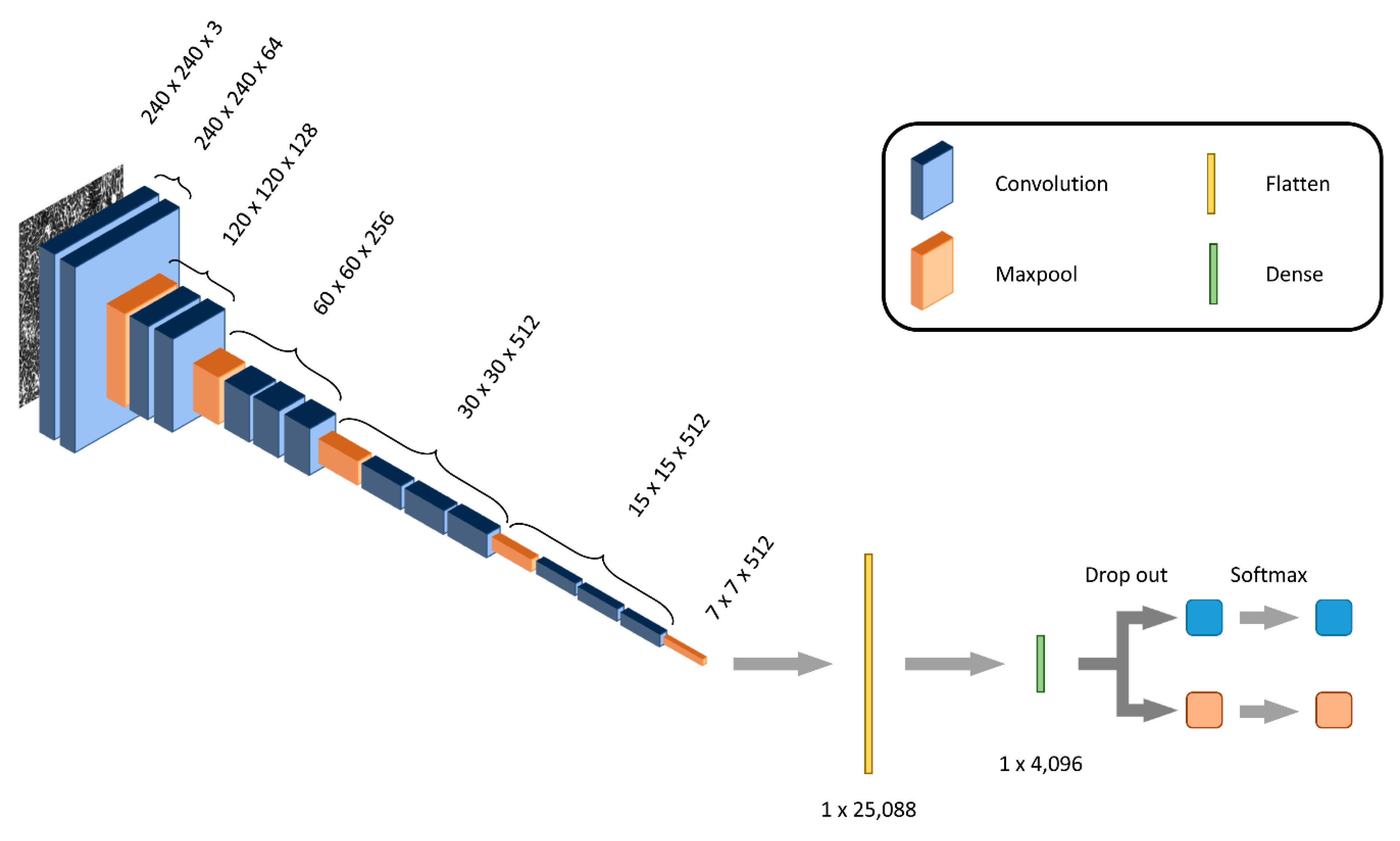
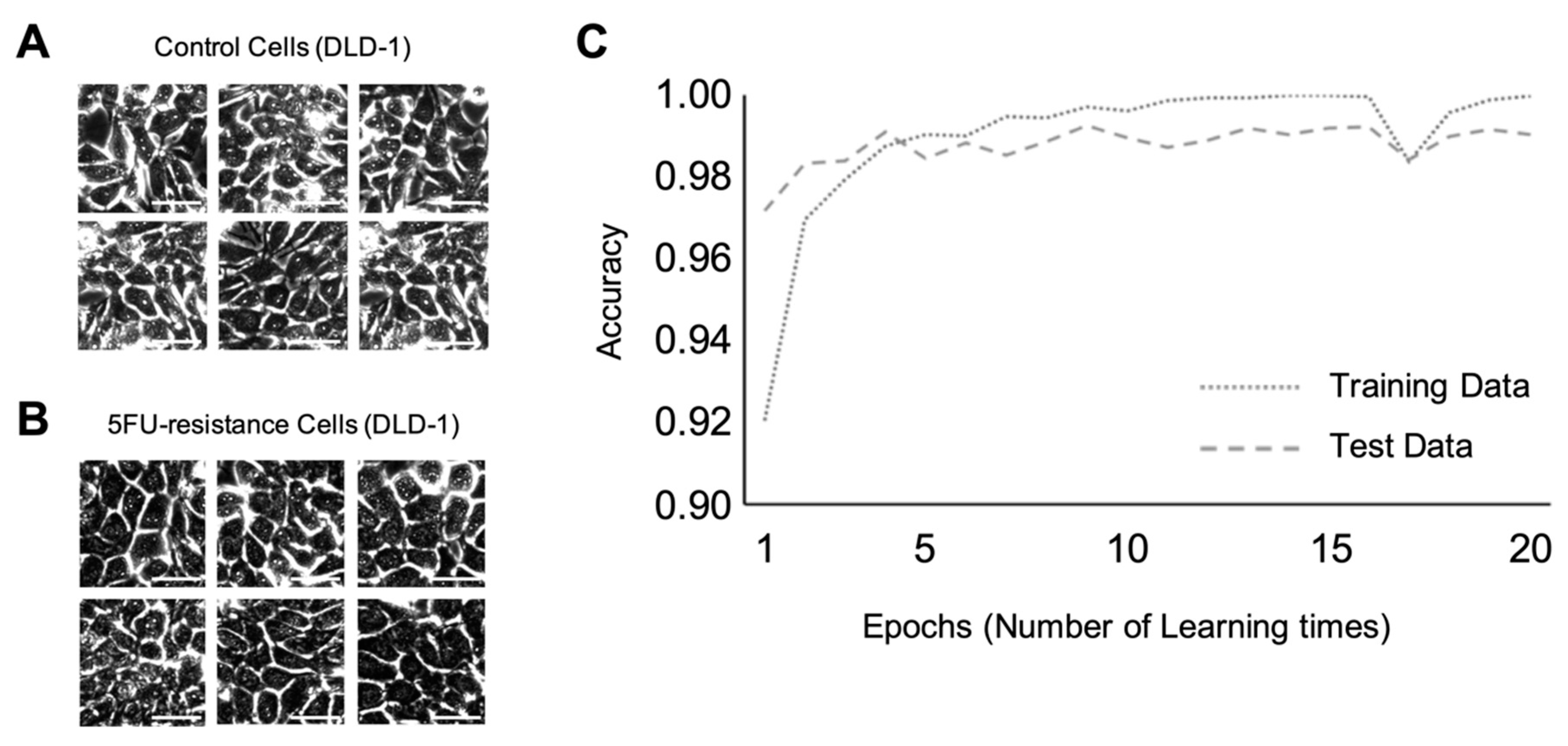
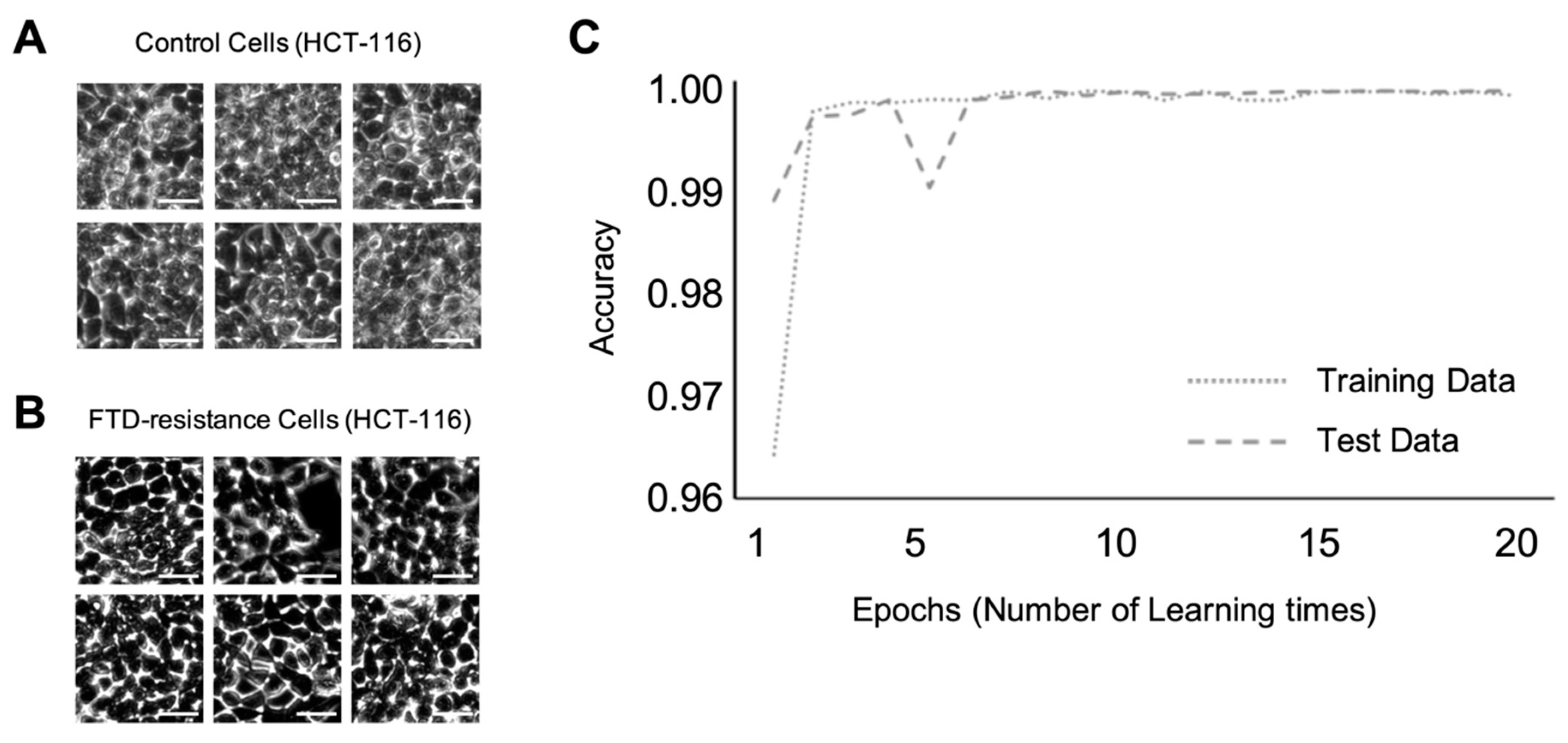
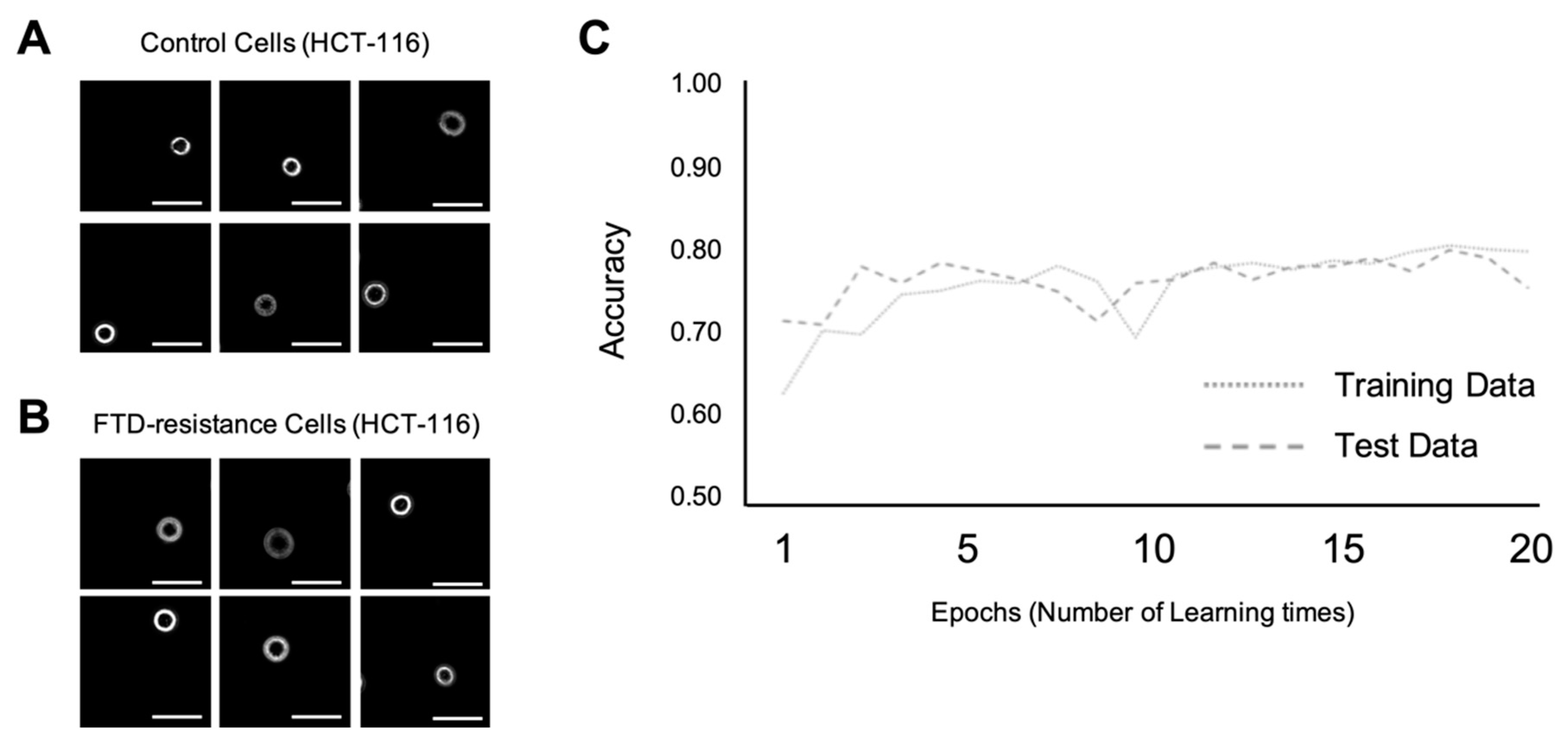
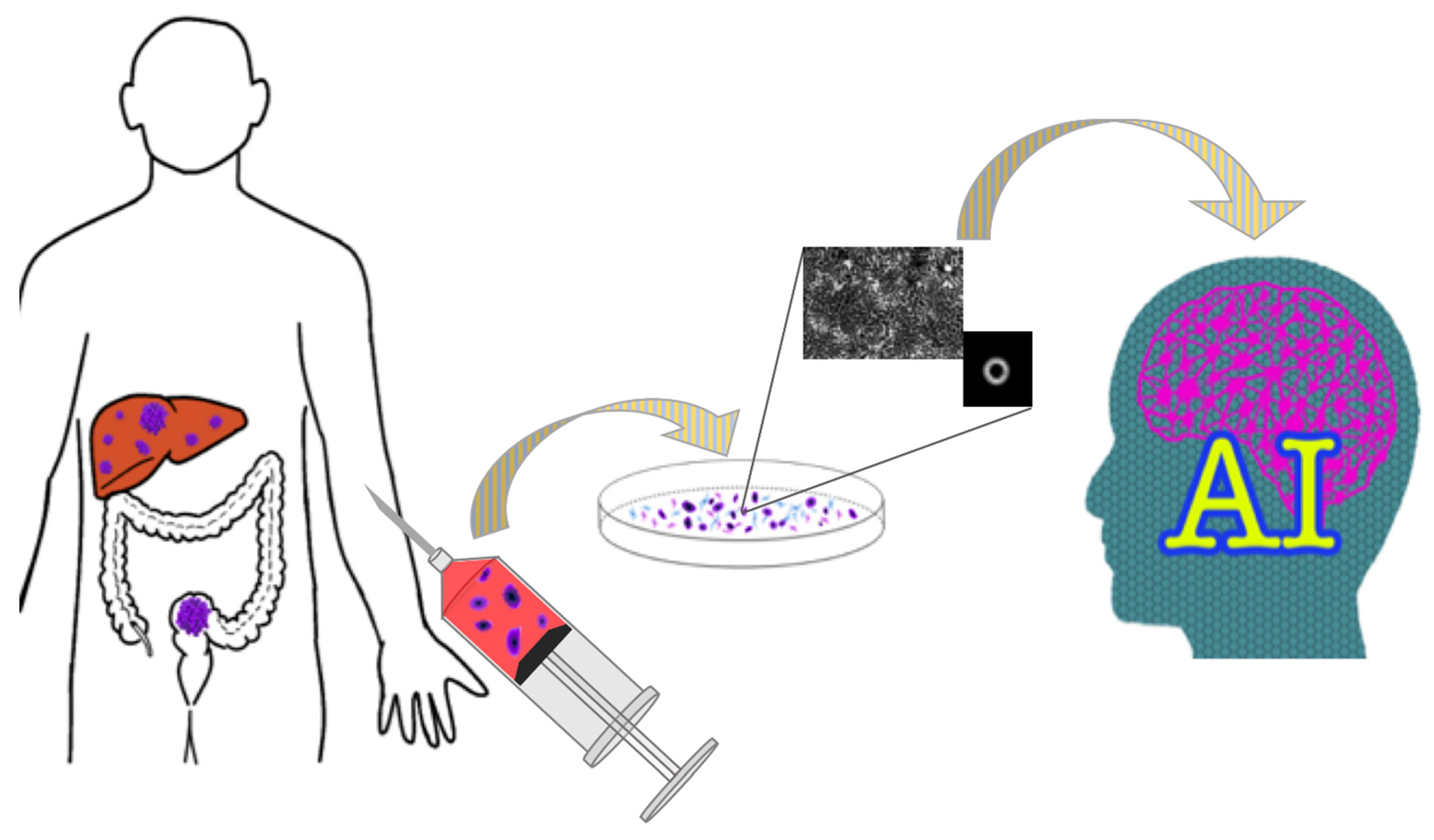
© 2020 by the authors. Licensee MDPI, Basel, Switzerland. This article is an open access article distributed under the terms and conditions of the Creative Commons Attribution (CC BY) license (http://creativecommons.org/licenses/by/4.0/).
Share and Cite
Yanagisawa, K.; Toratani, M.; Asai, A.; Konno, M.; Niioka, H.; Mizushima, T.; Satoh, T.; Miyake, J.; Ogawa, K.; Vecchione, A.; et al. Convolutional Neural Network Can Recognize Drug Resistance of Single Cancer Cells. Int. J. Mol. Sci. 2020, 21, 3166. https://doi.org/10.3390/ijms21093166
Yanagisawa K, Toratani M, Asai A, Konno M, Niioka H, Mizushima T, Satoh T, Miyake J, Ogawa K, Vecchione A, et al. Convolutional Neural Network Can Recognize Drug Resistance of Single Cancer Cells. International Journal of Molecular Sciences. 2020; 21(9):3166. https://doi.org/10.3390/ijms21093166
Chicago/Turabian StyleYanagisawa, Kiminori, Masayasu Toratani, Ayumu Asai, Masamitsu Konno, Hirohiko Niioka, Tsunekazu Mizushima, Taroh Satoh, Jun Miyake, Kazuhiko Ogawa, Andrea Vecchione, and et al. 2020. "Convolutional Neural Network Can Recognize Drug Resistance of Single Cancer Cells" International Journal of Molecular Sciences 21, no. 9: 3166. https://doi.org/10.3390/ijms21093166
APA StyleYanagisawa, K., Toratani, M., Asai, A., Konno, M., Niioka, H., Mizushima, T., Satoh, T., Miyake, J., Ogawa, K., Vecchione, A., Doki, Y., Eguchi, H., & Ishii, H. (2020). Convolutional Neural Network Can Recognize Drug Resistance of Single Cancer Cells. International Journal of Molecular Sciences, 21(9), 3166. https://doi.org/10.3390/ijms21093166





